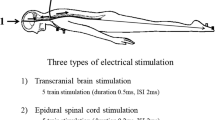Abstract
Intraoperative spinal cord monitoring using motor evoked potentials is a desirable goal, but the sensitivity of most techniques limits their value during anaesthesia. This paper examines the effects of various anaesthetic agents on three different MEP recording techniques in 41 adult cats.
Access this chapter
Tax calculation will be finalised at checkout
Purchases are for personal use only
Preview
Unable to display preview. Download preview PDF.
Similar content being viewed by others
References
Toda Y. The effect of anesthetic agents on descending spinal evoked potentials and the compound muscle action potentials elicited by stimulation of the cerebral motor cortex and the spinal cord. Journal of the Japanese Orthopaedic Association. 1992;66:279–290.
Zentner J, Ebner A. Nitrous oxide suppresses the electromyographic response evoked by electrical stimulation of the motor cortex. Neurosurgery. 1989;24(1):60–62.
Levy WJ, McCaffrey M, York DH, Tauzer F. Motor evoked potentials from transcranial stimulation of the motor cortex in cats. Neurosurgery. 1984;15(2):214–227.
de Jong RH, Robles R, Heavner JE. Suppression of impulse transmission in the cats doral horn by inhalational anesthetics. Anesthesiology. 1970;32:440–445.
Taylor BA, Fennelly ME, Farrell J. Intraoperative spinal cord monitoring with combined motor and sensory spinal evoked potentials. Journal of Bone and Joint Sugery (Br). 1992;74BSupp. 1:83–84.
Editor information
Editors and Affiliations
Rights and permissions
Copyright information
© 1994 Springer Science+Business Media Dordrecht
About this chapter
Cite this chapter
Toda, Y., Tamaki, T., Taylor, B., Ogawa, R. (1994). The effect of anaesthetic agents on descending spinal cord evoked potential and the compound muscle action potentials elicited by stimulation at the motor cortex and the spinal cord. In: Jones, S.J., Hetreed, M., Boyd, S., Smith, N.J. (eds) Handbook of Spinal Cord Monitoring. Springer, Dordrecht. https://doi.org/10.1007/978-94-011-1416-5_62
Download citation
DOI: https://doi.org/10.1007/978-94-011-1416-5_62
Publisher Name: Springer, Dordrecht
Print ISBN: 978-94-010-4619-0
Online ISBN: 978-94-011-1416-5
eBook Packages: Springer Book Archive




